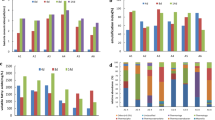Abstract
The distribution of indigenous microorganisms was surveyed in Block 1 of Daqing Oilfield. Based on this survey, the indigenous microorganisms in the formation water were activated with different activator systems at the simulated stratum ecological environment. The changes of the number of bacteria of various physiological groups were determined during the process of activation. Also changes of pH value and composition of gas productions were analyzed at the end of culturing. The results showed that the selected block formation water contained a great number of saprophytic bacteria, hydrocarbon-oxidizing bacteria, fermentative bacteria, methane-producing bacteria and sulfate-reducing bacteria. Under the conditions that the growth of sulfate-reducing bacteria was controlled the block had the potential to enhance oil recovery by activating beneficial bacteria. The growth of sulfate-reducing bacteria can be inhibited through the activation of nitrate-reducing bacteria. The number of nitrate-reducing bacteria reached 106–107 cells/mL, but sulfate-reducing bacteria reached only 0–45 cells/mL in A system. Methane-producing bacteria can be activated by C, D activators. The relative content of biological methane in the light hydrocarbon gas reached 80% in C, D systems. B activator was conducive to the propagation of acid-producing bacteria, so that the pH value of the culture medium decreased from 7.5 to around 5.0. Hydrocarbon-oxidizing bacteria can be activated by various activator systems. There was low molecular light hydrocarbon in gas production according to the analysis of gas chromatograph. According to the content of methane and the number of methane-producing bacteria, methane only can be generated through activating methane-producing bacteria. By choosing different activator systems, various populations of indigenous microorganisms can be activated accordingly.
Similar content being viewed by others
References
Ivanov M V, Belyaev S S. Biotechnology of enhancement of oil recovery based on the geochemical activity of microorganisms (field experiment). Dev Petrol Sci, 1991, 31: 421–432
Nazina T N, Xue Y F, Wang X Y, et al. Diversity and activity of microorganism in the Daqing Oil Field of China and their potential for biotechnological application. Res Environ Biotechnol, 2000, 3(1): 121–132
Nazina T N, Sokolova D Sh, Shestakova N M, et al. The phylogenetic diversity of aerobic organotrophic bacteria from the Dagang high-temperature oil field. Microbiology, 2005, 74(3): 343–351
Belyaev S S, Glumov I F, Ibatullin R R, et al. Activation of the geochemical activity of stratal microflora as the basis of a biotechnology for enhancement of oil recovery. Microbiology, 1998, 67(6): 708–714
Xiang T S, Feng Q X, Nizina N T, et al. Mechanism of indigenous microbial enhancement of oil recovery and pilot test (in Chinese). Acta Petrolei Sin, 2004, 25(6): 63–67
Feng Q X, Yang H J, Nizina N T, et al. Pilot test of indigenous microorganism flooding in Kongdian Oilfield (in Chinese). Petrol Expl Dev, 2005, 32(5): 125–129
Cheng H Y, Wang X L, Xu D T, et al. Experiments on EOR employing indigenous microorganisms (in Chinese). Petrol Expl Dev, 2006, 33(1): 91–94
Bao M T, Wang W D, Wang X L, et al. Microbial enhanced oil recovery by activation of stratal microflora: A review (in Chinese). Oilfield Chem, 2002, 19(4): 382–386, 361
Krista M K, Grigoriyan A, Jenneman G, et al. Effect of nitrate and nitrite on sulfide production by two thermophilic sulfate-reducing enrichments from an oil field in the North Sea. Appl Microbiol Biotechnol, 2007, 75: 195–203
Videla H A, Herrera L K. Microbiologically influenced corrosion: looking to the future. Int Microbiol, 2005, 8(3): 169–180
Londry K L, Suflita J M. Use of nitrate to control sulfide generation by sulfate-reducing bacteria associated with oily waste. J Indus Microbiol Biotechnol, 1999, 22: 582–589
Davidova I, Hicks M S, Fedorak P M, et al. The influence of nitrate on microbial processes in oil industry production waters. J Indus Microbiol Biotechnol, 2001, 27: 80–86
Larsen J, Rod M H, Zwolle S. Prevention of reservoir souring in the Halfdan field by nitrate injection. Conosion 2004 NACE International, Houston, TX, 2004, Paper 0476 1
Telang A J, Ebert S, Foght J M, et al. Effect of nitrate injection on the microbial community in an oil field as monitored by reverse genome probing. Appl Environ Microbiol, 1997, 63: 1785–1793
Hubert C, Nemati M, Jenneman G, et al. Corrosion risk associated with microbial souring control using nitrate or nitrite. Appl Microbiol Biotechnol, 2005, 68: 272–282
Greene E A, Hubert C, Nemati M, et al. Nitrite reductase activity of sulfate-reducing bacteria prevents their inhibition by nitrate-reducing, sulfur-oxidizing bacteria. Environ Microbiol, 2003, 5: 607–617
Bao M T, Kong X P, Song Y T, et al. Selective activation condition of stratal microflora of S12 block in Shengli Oilfield (in Chinese). J China Univ Petroleum (natural sci ed), 2004, 28(6): 44–48
Koch A L. Most probable numbers. In: Methods for General and Molecular Bacteriology. Washington D C: Am Soc Microbiol, 1994. 257–260
Postgate J R. The Sulfate-reducing Bacteria. 2nd ed. Cambridge: Cambridge University Press, 1984. 25–60
Bonch Osmolovskaya E A, Miroshnichenko M L, Lebe Dinsky A V, et al. Culture-based Dagang high-temperature oilfield and oligonucleotide microchip analyses of thermophilic microbial communities in a continental high-temperature petroleum reservoir. Appl Environ Microbiol, 2003, 69: 6143–6151
Author information
Authors and Affiliations
Corresponding author
Additional information
Supported by the National High Technology Research and Development Program of China (Grant No. 2008AA06Z204) and Natural Science Foundation of Hubei Province of China (Grant Nos. 2004ABA144, 2007ABA020)
Rights and permissions
About this article
Cite this article
Xiang, T., Liu, X., Zhang, M. et al. Distribution of the indigenous microorganisms and mechanisms of their orientational activation in Daqing Oilfield. Sci. China Ser. D-Earth Sci. 52 (Suppl 1), 128–134 (2009). https://doi.org/10.1007/s11430-009-5006-8
Received:
Accepted:
Published:
Issue Date:
DOI: https://doi.org/10.1007/s11430-009-5006-8




